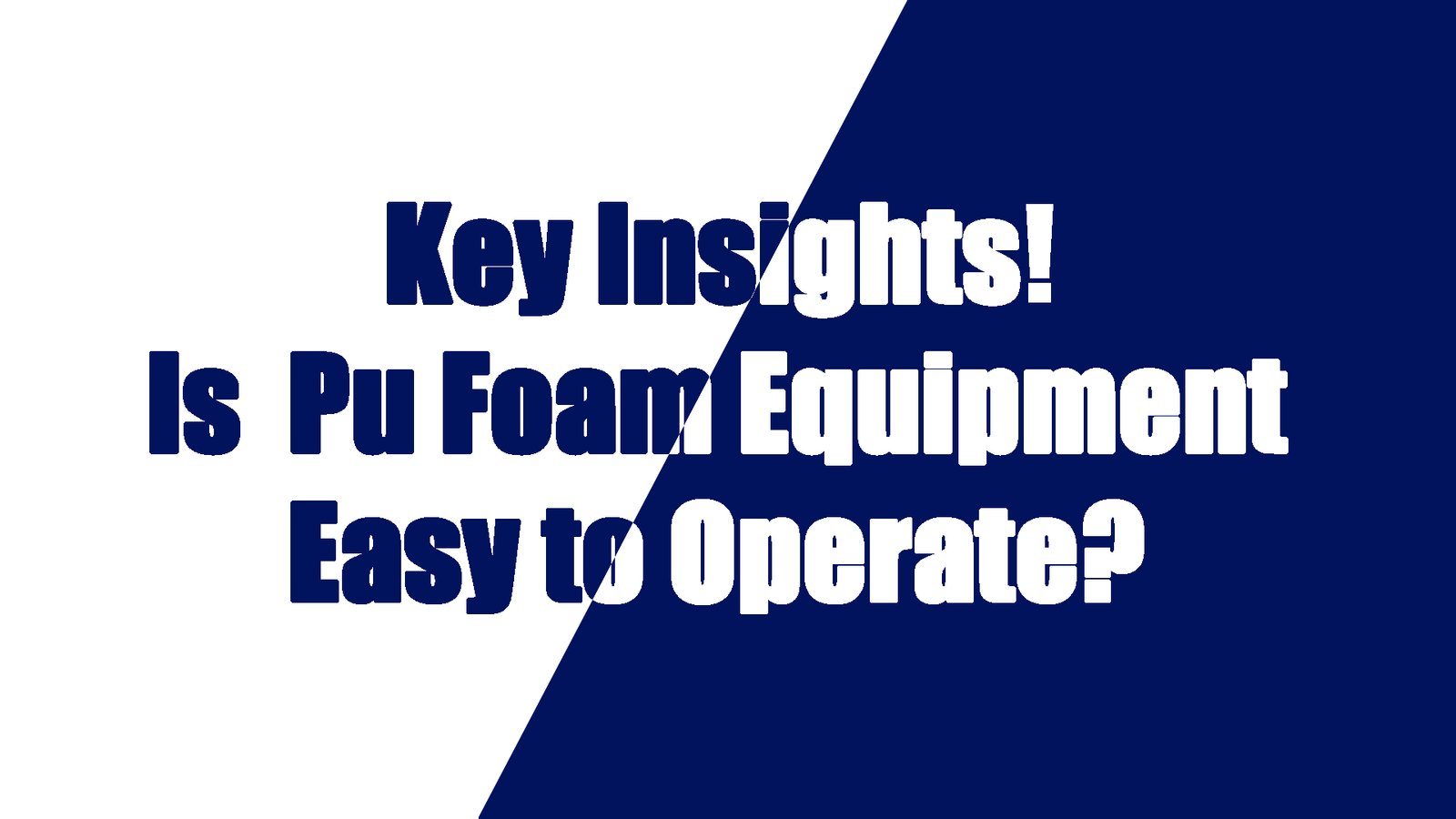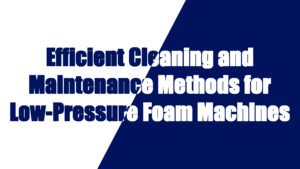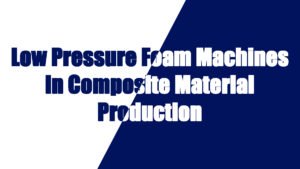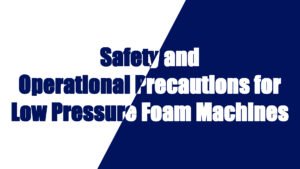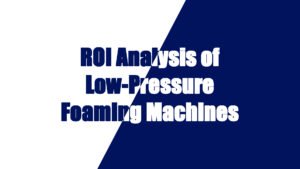Polyurethane foam equipment is widely used across various industries, including furniture, construction, automotive, and packaging. With advancements in technology and increased automation, operating polyurethane foam equipment has become more streamlined. However, this doesn’t mean that operators can entirely disregard the professional requirements for operating such equipment. The complexity of the operation and the level of training required depend on the type of equipment, its functions, and the products being manufactured. This article will explore the complexity of operating polyurethane foam equipment, the need for specialized training, and whether modern systems provide user-friendly interfaces and intelligent control systems.
Complexity of Operating Polyurethane Foam Equipment
The complexity of operating polyurethane foam equipment depends on the equipment’s design, functionality, and the type of product being produced. While modern equipment focuses on simplifying the operation process, the polyurethane foam manufacturing process still involves a number of technical details and steps. Therefore, operators need to be familiar with various aspects of the equipment’s operation, especially when adjusting parameters, handling special raw materials, and performing maintenance.
Raw Material Mixing and Proportion Control
The quality of polyurethane foam is highly dependent on the ratio of raw materials used. During the foaming process, the proportion of polyols, isocyanates, catalysts, and blowing agents must be carefully controlled. Modern equipment is typically equipped with precise dosing systems that automate the mixing of materials, but operators still need to understand the properties of these materials and the necessary ratios for different products. In large-scale or complex production runs, operators may need to intervene manually, particularly when switching between product specifications or raw material types.
Temperature and Pressure Control
During the foaming process, it is essential to maintain precise control over temperature and pressure. If not managed correctly, the foam quality can be unstable, and the equipment could be damaged. Modern equipment usually includes high-precision temperature and pressure control systems that automatically adjust according to the type of raw material or product. However, operators must understand the temperature control systems well enough to respond quickly in case of fluctuations, ensuring that product quality and production efficiency are not compromised.
Automation and Manual Intervention
While modern polyurethane foam equipment is increasingly automated, such as automatic mixing, dosing, and foaming time control, certain situations may still require manual intervention. For example, when there is equipment maintenance, troubleshooting, or specific product quality issues, operators need to have the necessary technical expertise to resolve the problem quickly. Although automation reduces the need for manual control, having skilled operators is still essential to ensure smooth operations and high-quality output.
Is Professional Training Necessary?
Although the operation of modern polyurethane foam equipment is becoming more user-friendly with enhanced automation, professional training remains crucial for ensuring optimal performance and production efficiency. The need for training can be broken down into several key areas:
Equipment Operation and Basic Knowledge
Operating polyurethane foam equipment requires basic knowledge of the foaming process, raw material characteristics, and how the system functions. Training can help operators understand the key components of the equipment, how the various functions work together, and how to handle the equipment safely. Proper training ensures that operators are aware of the device’s technical specifications, control systems, and maintenance procedures, thereby reducing the risk of errors and ensuring smooth production.
Raw Material Management and Proportion Adjustment
Since the quality of the polyurethane foam product directly depends on the correct ratio of raw materials, operators need to be proficient in adjusting these ratios to suit different product needs. This skill is particularly important when switching between different foam product types. Training ensures that operators are capable of handling complex formulations, thus preventing production issues such as poor foam quality or equipment malfunctions due to improper material handling.
Troubleshooting and Maintenance Skills
While modern equipment comes with various automatic protection mechanisms, equipment failure is still inevitable. In such cases, operators must be able to diagnose the issue quickly and effectively. Professional training teaches operators how to troubleshoot common problems, identify faulty components, and perform basic repairs. This reduces downtime, ensures that production continues smoothly, and minimizes the risk of significant equipment damage.
Safety Protocols
Polyurethane foam production involves chemical reactions, temperature fluctuations, and pressurization. It is essential to follow safety protocols to ensure the well-being of the operators and the safe operation of the equipment. Professional training helps operators understand safety standards, emergency procedures, and hazard prevention methods, reducing the chances of accidents during operation.
User-Friendly Interfaces and Intelligent Control Systems
With the increasing advancement of technology, more polyurethane foam equipment is being equipped with intelligent control systems and user-friendly interfaces, which greatly simplify the operation process. These systems help operators monitor, control, and troubleshoot the equipment with greater ease, especially in settings that involve production scale-ups, product changes, or process adjustments.
Touchscreen Controls and Graphical Interfaces
Many modern polyurethane foam machines now include touchscreen control systems. These user-friendly interfaces allow operators to adjust equipment settings such as temperature, pressure, and material ratios with a simple tap. The graphical display makes it easy for operators to visualize and control the foaming process. Furthermore, real-time data on the machine’s operation, including production statistics and any alerts, is readily available, enabling operators to monitor the system effectively.
Intelligent Monitoring and Automatic Adjustments
Intelligent monitoring systems are another key feature of modern equipment. These systems automatically collect and analyze data on the machine’s operation. If any parameters fall outside optimal ranges, the system can automatically adjust temperature, pressure, or material feed rates to ensure that the process stays within the required specifications. This reduces the need for manual intervention and ensures the stability of the foaming process, leading to consistent product quality.
Fault Diagnosis and Warning Systems
Modern equipment is often equipped with diagnostic and warning systems that can identify faults in real time. When an issue occurs, the system immediately detects the problem, provides a description of the issue, and may even suggest possible solutions. This feature enables operators to address problems quickly and avoid long periods of downtime. By providing proactive maintenance alerts and step-by-step repair guidance, these intelligent systems significantly reduce the impact of equipment failures on production.
In summary, while modern polyurethane foam equipment is designed to be easier to operate due to advancements in automation and intelligent control systems, it still requires operators to have a certain level of technical knowledge and expertise, especially when it comes to adjusting parameters, handling raw materials, and performing maintenance. Although intelligent systems and user-friendly interfaces have simplified the process, professional training remains crucial to ensure the equipment is operated optimally. Proper training empowers operators to handle equipment with greater confidence, troubleshoot issues quickly, and improve product quality, thereby reducing the likelihood of costly mistakes and minimizing downtime.
Incorporating automated systems and user-friendly features makes the equipment more accessible to operators, but it is the combination of professional training and intelligent systems that ensures maximum operational efficiency. Therefore, businesses should prioritize operator training and technical support when implementing polyurethane foam equipment to achieve optimal production performance and long-term success.


















